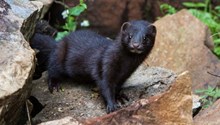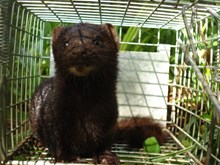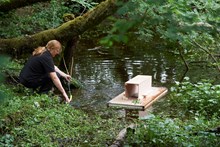19 February, 2019
Could you help stop mink in their tracks?

A major new project working in Highland and Eastern Perthshire, the Scottish Invasive Species Initiative, is looking for people to get involved in work to help remove American mink from the countryside.
The invasive American mink was brought to Scotland for fur-farming in 1938 and, as a consequence of both escapes and deliberate releases, became established in the wild in the 1960s.
Mink are opportunistic and ferocious hunters taking whatever prey is available to them - often killing more than they require for food at that time. Their presence in the countryside has a devastating effect on native Scottish wildlife, particularly ground nesting birds and water vole populations.
Scottish Invasive Species Initiative Project Officer for the Tayside area, Mark Purrmann-Charles, explained: “This time of year is critical for our mink work. We really need to control mink before they breed; one female mink hunting a 4km stretch of river can take 100 water voles over the 3-4 months of feeding her young - that is ten water vole colonies, often an entire local population, wiped out. We really want to remove them in spring before they breed and their young spread widely and cause devastation to native wildlife.
"We’ve already got some fantastic volunteers helping the project and have a good coverage between Dunkeld and Ballinluig – though we are always keen to improve that network further. We are particularly interested in recruiting volunteers in areas around Blairgowrie and Rattray, Couper Angus, Carse of Gowrie and both the Aberfeldy and Pitlochry areas. It would also help to have more people involved in the Luncarty – Stanley area too.”
Volunteers can help by adopting a mink raft from the project. Monitoring a mink raft requires no previous experience, is easy to do and the project team provide all equipment and full training at the start and will help set the raft up. The raft contains a clay pad hidden inside a tunnel and the tell-tale sign of mink presence is when they leave their footprints in the clay as they explore inside the tunnel. Once the raft is set up the volunteer just needs to check it for footprints every 1-2 weeks.
With the help of volunteers, local community groups and schools, the project is building a network of such rafts north of Perth, in the River Tay and River Tummel catchment areas, allowing for the quick detection of any mink. Once mink are detected a live-capture trap is put on the raft and the mink caught before being humanely despatched.
Callum Sinclair, Project Manager, Scottish Invasive Species Initiative, commented: “The Scottish Invasive Species Initiative is building on the work of previous mink control projects, most recently the Scottish Mink Initiative, to continue mink control across more than 29,500km2 of northern Scotland. To make a difference at this scale we are working with ten different fishery trusts and coordinating and pooling our efforts.
"In addition to northern Perthshire, our mink control network extends across Angus, Aberdeenshire, Moray and Highland. We know we can’t deal with mink on our own and so the success of our control work hangs on the support and dedication of our growing network of volunteers adopting rafts and helping monitor for their presence and support their removal.”
The Scottish Invasive Species Initiative is using established scientific methodology and information to target its work. Central to this is the University of Aberdeen which, as an academic partner, provides expert scientific knowledge and advice to inform the establishment of the raft network and undertake further research into mink predator and prey dynamics and impacts.
Professor Xavier Lambin, from the University of Aberdeen School of Biological Sciences, said: “The American mink is an opportunistic predator which is also a very effective coloniser of new areas. Mink can travel large distances to take up new territories (25% will travel 80km to take up a territory) and so control needs to be on a large scale to protect cleared areas from re-colonisation.
"From our previous work in Scotland we have gathered good information on mink behaviours, the most likely locations for breeding females and where the most suitable mink habitats lie. With that knowledge we can target efforts to these areas to have maximum impact on mink numbers and consequently deliver maximum benefits for native wildlife.”
Anyone interested in getting involved or who would like more information should contact local Tayside project officer Mark Purrmann-Charles on markeskrivers@gmail.com or 07741 639556.
To find out more about the Scottish Invasive Species Initiative or volunteering with the wider project visit www.invasivespecies.scot , follow on social media or contact the team on sisi@nature.scot
NatureScot is Scotland's nature agency. We work to enhance our natural environment in Scotland and inspire everyone to care more about it. Our priority is a nature-rich future for Scotland and an effective response to the climate emergency. For more information, visit our website at www.nature.scot or follow us on X at https://x.com/NatureScot
’S e NatureScot buidheann nàdair na h-Alba. Bidh sinn a’ neartachadh àrainneachd na h-Alba agus a’ brosnachadh dhaoine gu barrachd suim a chur ann an nàdar. Tha e mar phrìomhachas againn gum bi nàdar na h-Alba beairteach agus gun dèilig sinn gu h-èifeachdach le èiginn na gnàth-shìde. Tha an tuilleadh fiosrachaidh aig www.nature.scot no air X aig https://x.com/NatureScot





